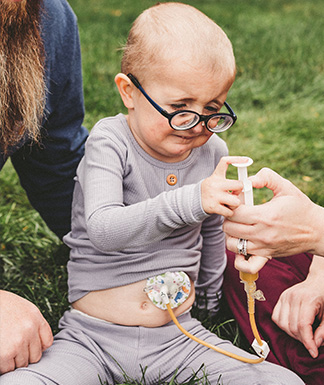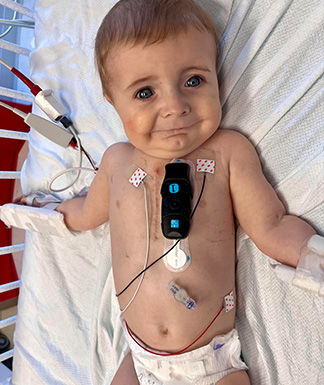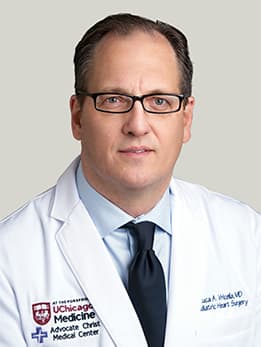Treating kids with Marfan syndrome

As a newborn, Jameson Justen struggled to breathe due to low muscle tone and airway issues. He also had unusually long fingers and toes with contractures of his fingers. An echocardiogram showed marked abnormalities of his mitral and tricuspid valves and a severely dilated aorta and main pulmonary artery. Genetic testing revealed that Jameson had Marfan syndrome.
A pathogenic variant in the gene coding for fibrillin-1 (FBN1) causes Marfan syndrome. While there are hundreds of different pathogenic variants associated with the disorder, the variant Jameson has causes more rapidly progressive disease.

Marfan syndrome is a systemic disorder of connective tissue with a high degree of clinical variability affecting the ocular, skeletal and cardiovascular systems. Major morbidity and early mortality relate to the cardiovascular system and include dilatation of the aorta, mitral and tricuspid valve prolapse with regurgitation and heart failure in smaller children. With proper management, however, people with Marfan syndrome have a life expectancy almost similar to the general population.
To meet the needs of patients with Marfan syndrome and other forms of connective tissue disorders, the Chicago Marfan and Related Connective Tissue Disorder Program was established in 2020. “Over the last 15 years, huge advances have been made in the diagnosis and medical and surgical management of patients with Marfan syndrome, related connective-tissue disorders, and heritable forms of aortic aneurysm and dissection syndromes,” said Michael G. Earing, MD, who directs the program. “Our understanding of the genetics associated with these syndromes allows us to test all patients and their families and then tailor their management and follow-up based on their specific genes.”
In 2023, the Chicago Marfan and Related Connective Tissue Disorder Program was certified by the Marfan Foundation as a Center of Excellence, one of only three centers in Illinois. “Our program is very unique in that we have a multidisciplinary team that is designed to see both children and adults in the same setting, providing seamless and continuous care through their lifetime,” said Earing.
To earn the Center of Excellence certification, the Chicagoland Children’s Health Alliance—a consortium of Comer Children’s Hospital, Advocate Children’s Hospital, and Endeavor Health—had to demonstrate that it had developed a multidisciplinary team of subspecialists to treat all the complications of Marfan and genetically related syndromes. A patient may see an orthopedic surgeon who specializes in scoliosis, a general surgeon who repairs hernias and does pectus excavatum repairs, a pediatric or adult cardiovascular surgeon, neurologist, neurosurgeon, dermatologist and ophthalmologist who have expertise caring for the unique conditions of Marfan syndrome. Many of these patients can develop premature arthritis and have issues with pain, so pain specialists and psychologists are also part of the team, along with social workers who help ensure lifetime comprehensive care and services.
As both a pediatric and adult trained cardiologist, Earing is in a unique position to care for the entire family, from birth through adulthood. “Care and surveillance can be adjusted to meet the specific challenges for a given family, which is a major advantage of our program,” says Earing. “We offer real-time genetic testing in all our clinics, so we can diagnose patients early and monitor them before problems occur. It’s not unusual for our center to be treating a child, a parent, and a grandparent from one family, all of whom have Marfan’s or another connective-tissue disorder.”
Early diagnosis offers an opportunity to intervene with medical therapies that can slow the progression of Marfan’s and other genetic causes of aortic aneurysm. “Clinical trials have found that medical therapies may slow the rate of aortic dilation and may prevent aortic complications over time, potentially eliminating the need for surgery,” said Earing.
Patients may be on medications such as beta blockers or angiotensin receptor blockers to slow aortic root dilation and prevent emergent dissections, said Rachel Barsella, DNP, Advanced Practice Nurse for Chicago Adult Congenital Heart Disease Alliance. “These classes of medication are safe and effective in both children and adults with recommended follow-up,” she said.
Surgery to fix and prevent aortic complications
While Jameson was still in the NICU, Earing reached out to the infant’s mother, Amanda, to initiate care of her son’s complex medical needs. “I didn’t know anything about Marfan syndrome at that point, and I was so grateful that Dr. Earing immediately began coordinating Jameson’s care so I didn’t have to assume the responsibility of finding specialists,” said Amanda. Earing monitored Jameson monthly to assess the size of his aorta and the extent of his valve regurgitation, and prescribed beta blockers to slow the enlargement of his aorta. But at age six months, Jameson’s heart was failing from leaky mitral and tricuspid valves.

“Children who present with infantile Marfan syndrome usually have very aggressive mitral valve disease, whereas adolescents will more often require surgery for aortic root aneurysms with or without concomitant mitral valve repair,” said Luca A. Vricella. MD, Director of Pediatric Cardiac Surgery. Vricella performed open-heart surgery on Jameson to repair his mitral and his tricuspid valves with the expectation that Jameson will need aortic surgery in the future.
In pediatric patients, Vricella has perfected a prophylactic surgical technique called valve-sparing aortic root replacement, which replaces the aorta and the aortic root to prevent it from further enlarging and catastrophically rupturing, while preserving the native aortic valve and avoiding its replacement with a prosthesis. Vricella has done more of these procedures in infants and young children than any other surgeon world-wide and has published extensively on the surgical technique.
“Valve-sparing aortic root replacement in children has many nuances and requires gentle handling of fragile aortic tissues and modifications to prevent downstream complications,” said Vricella, who is trained in both adult and pediatric cardiac surgery. “Most cardiac surgeons don’t do this procedure, and especially not in children. We have an aggressive surgical program that thrives on very complicated procedures, which is why we have patients referred to us nationally and internationally for surgical and medical treatment of connective tissue disorders and cardiovascular complications.”
The younger children are when they are diagnosed with Marfan syndrome, the greater the likelihood they will have profound heart failure. “In addition to surgical expertise, we have the ability to provide very attentive pre- and postoperative cardiac care of these patients,” said Vricella.
Hospitals in the Chicagoland Children’s Health Alliance also have advanced axial imaging, which allows the surgeons to assess the severity of the disease preoperatively and provide a surgical roadmap, since patients often need simultaneous procedures on the aortic arch and the aortic root. And although surgery prevents potentially lethal aortic rupture, patients need lifelong axial imaging to detect aneurysms on the rest of the vascular tree or pseudo aneurysms that can arise late following surgical intervention. “These patients need constant surveillance,” said Vricella.
In addition to Earing and Vricella, three-year-old Jameson currently sees a pulmonologist to manage his obstructive sleep apnea, an ophthalmologist and a retina specialist, and a physiatrist to manage his mobility issues, which require braces for his ankles and a walker. “Jameson attends preschool and is the happiest boy,” said Amanda. “He has overcome so much and he’s thriving, which is a joy to see.”

Reducing the risk of aortic dissection
In ongoing research at UChicago Medicine, the team is analyzing the biomechanical properties of the aortic wall in patients who have aortic aneurysms to determine if medical therapies can modify the stiffness of the aortic wall. “We are also investigating markers that can help us predict if the aortic is at high risk of tearing or rupturing,” said Earing. “The mortality rate is very low if we electively repair the aorta versus emergently repairing a torn aorta, which has a mortality rate of 20%--if people make it to the hospital in time.” Additional research involves analyzing the effect of genetics on the aortic wall using surgical samples from a tissue bank at UChicago Medicine.
There are multiple clinic locations where the program sees patients throughout the Chicagoland Children’s Health Alliance. “Often we are able to schedule appointments for imaging, a cardiologist, a vascular surgeon, and a geneticist in one day, which is convenient for the patient and allows us to coordinate a plan of care with a multidisciplinary team,” said Barsella.
“It can be very frightening to have a child diagnosed with a disorder that requires lifelong care, but families have the reassurance that specialists in connective-tissue disease will closely monitor and treat their children into adulthood,” added Barsella.
“I have peace of mind about the continuity of care Jameson is receiving from a medical team that has known him since he was one month old,” said Amanda. “Dr. Earing is setting him up for success with his reassurances that Jameson will be able to walk and do normal activities with other kids. I always feel listened to and that my concerns are heard and addressed by the nursing staff and by Dr. Earing.”

Luca Vricella, MD
Luca Vricella, MD, is a highly renowned pediatric cardiac surgeon who is passionate about helping children have fulfilling lives after being treated for heart disease.
Learn more about Dr. VricellaPediatric Heart Care
The pediatric cardiology team at the University of Chicago Medicine Comer Children's Hospital brings patients the latest in heart research and treatments while delivering personalized, compassionate care to each family.
Learn more about our expertise